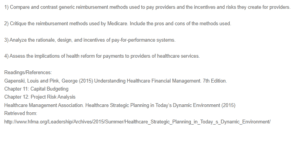Financial Management of Healthcare
Generic Reimbursement Methods
Fee-for-service (FFS) reimbursement mechanisms pay clinicians based on the number of services supplied, offering an incentive for doctors to conduct more operations but potentially leading to overutilization and increasing healthcare costs. Alternative approaches, such as pay-for-performance (P4P), tie reimbursement to quality measurements, motivating clinicians to provide high-quality treatment. Still, they run the danger of cherry-picking patients or focusing on easily measurable parts of care. Value-based reimbursement aligns incentives by tying payments to patient outcomes, promoting cost-effective and high-quality care; however, it also increases the danger of underpayment if risk adjustment mechanisms are not implemented correctly (Gapenski & Pink, 2015). Hire our assignment writing services in case your assignment is devastating you.
A Critique on Reimbursement Methods Used by Medicare
Medicare pays for services primarily through a combination of fee-for-service (FFS), bundled payments, and accountable care organizations (ACOs). FFS has the virtue of being simple and offering a clear payment structure, but it may favor volume above value. While bundled payments and ACOs aim to promote coordinated care and cost conservation, they can be difficult to implement and may face issues in effectively measuring and adjusting for patient risk, thereby leading to provider reimbursement inequalities. Overall, Medicare’s reimbursement mechanisms reflect a continual effort to strike a balance between encouraging excellence, managing costs, and maintaining beneficiaries’ access to treatment.
Rationale, Design, and Incentives of P4P Systems
P4P systems are intended to link financial incentives with the quality and efficiency of healthcare services. The goal of P4P is to improve overall healthcare quality by linking financial incentives to specific performance indicators, incentivizing providers to meet or surpass specified benchmarks (Bowen Scheurer et al., 2023). To ensure fairness and effectiveness, the design and implementation of P4P systems must carefully address the selection of relevant measures, potential unintended consequences such as “gaming” or cherry-picking patients, and the necessity for rigorous risk adjustment procedures.
Implications of Health Reform for Payments to Healthcare Providers
Health reform initiatives, such as the shift to value-based care, can affect payments to healthcare providers in several ways. There may be a greater emphasis on outcome-based reimbursement, promoting strategic planning around quality improvement and care coordination in order to optimize financial incentives (Healthcare Management Association, 2015). Second, the shift from fee-for-service models to bundled payments or accountable care arrangements may necessitate investments in new technologies and collaborative systems to effectively manage patient care across the continuum. Finally, addressing the complexities of developing reimbursement arrangements may require increased administrative capabilities and financial management tactics to ensure the long-term viability of healthcare organizations.
References
Bowen Scheurer, D., Adelman, K., Myerson, S., & Carley Reed, L. (2023). Medical University of South Carolina case study: A structured approach to improving quality metrics for achieving maximum pay-for-performance incentive payments. Management in Healthcare, 7(3), 237–249. https://www.ingentaconnect.com/content/hsp/mih/2023/00000007/00000003/art00005
Gapenski, L. C. & Pink G. H. (2015). Understanding healthcare financial management (7th ed.). Health Administration Press. https://lsms.ac/wp-content/uploads/2023/02/14..pdf
Healthcare Management Association. (2015). Healthcare strategic planning in today’s dynamic environment. HFMA. http://www.hfma.org/
ORDER A PLAGIARISM-FREE PAPER HERE
We’ll write everything from scratch
Question

Financial Management of Healthcare
1) Compare and contrast generic reimbursement methods used to pay providers and the incentives and risks they create for providers.
2) Critique the reimbursement methods used by Medicare. Include the pros and cons of the methods used.
3) Analyze the rationale, design, and incentives of pay-for-performance systems.
4) Assess the implications of health reform for payments to providers of healthcare services.
Readings/References:
Gapenski, Louis and Pink, George (2015) Understanding Healthcare Financial Management. 7th Edition.
Chapter 11: Capital Budgeting
Chapter 12: Project Risk Analysis
Healthcare Management Association. Healthcare Strategic Planning in Today’s Dynamic Environment (2015)
Retrieved from:
http://www.hfma.org/Leadership/Archives/2015/Summer/Healthcare_Strategic_Planning_in_Today_s_Dynamic_Environment/

